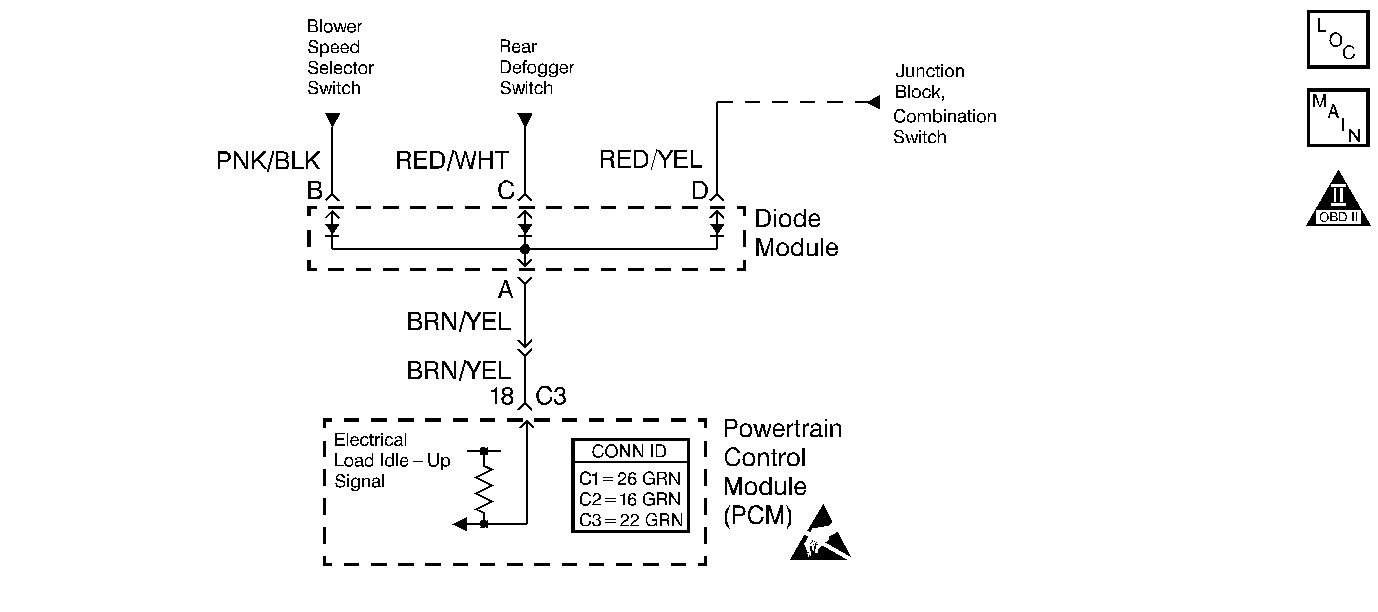
Circuit Description
The powertrain control module (PCM) receives an electrical load idle-up signal from the diode module. The electrical load idle-up signal is present when one or more of the following systems is turned ON:
| • | Headlights |
| • | The Rear-Window Defogger |
| • | The Heater Blower Motor |
The idle air control (IAC) valve increases the idle air passage opening for the additional electrical load compensation.
Diagnostic Aids
A short to ground in the signal circuit between the diode module and the PCM may cause an open in the TAIL fuse.
Check for a faulty electrical connection to the PCM.
An intermittent malfunction may be caused by a fault in the electrical load idle-up circuit. Inspect the wiring harness and the components for any of the following conditions:
| • | Backed out terminals |
| • | Incorrect mating of terminals |
| • | Broken electrical connector locks |
| • | Incorrectly formed terminals or damaged terminals |
| • | Faulty terminal-to-wire connections |
| • | Physical damage to the wiring harness |
| • | A broken wire inside the insulation |
| • | Corrosion of electrical connections, of splices, or of terminals |
Test Description
The numbers below refer to the step numbers in the diagnostic table.
-
The Powertrain OBD System Check prompts the technician to complete some basic checks, and to store the applicable freeze frame data on the scan tool. This creates an electronic copy of the data that was taken when the fault occurred. The scan tool stores the information for later reference.
-
This step checks for the electrical load idle-up signal to the PCM.
-
This step checks for each electrical input to the diode module.
Step | Action | Value(s) | Yes | No | ||||||
|---|---|---|---|---|---|---|---|---|---|---|
Did you perform the Powertrain On-Board Diagnostic (OBD) System Check? | -- | |||||||||
|
Important: If the rear defogger, the headlights, or the blower motor do not operate, immediately diagnose those components.
Did the scan tool indicate YES when each of the accessories was turned ON, and NO when the accessory was turned OFF? | -- | Go to Diagnostic Aids | ||||||||
3 | Did the engine speed increase with at least one of the accessories turned ON? | -- | ||||||||
4 |
Does the test lamp illuminate? | -- | ||||||||
5 |
Was a repair necessary? | -- | ||||||||
6 |
Was a repair necessary? | -- | ||||||||
Check the applicable systems that did not cause an increase in the engine speed.
Were any repairs necessary? | -- | |||||||||
8 | Replace the diode module. Refer to Diode Module Replacement . Is the action complete? | -- | -- | |||||||
9 | Replace the PCM. Is the action complete? | -- | -- | |||||||
10 | Operate the vehicle within the conditions under which the original symptom was noted. Does the system now operate correctly? | -- | System OK | Go to Diagnostic Aids |
